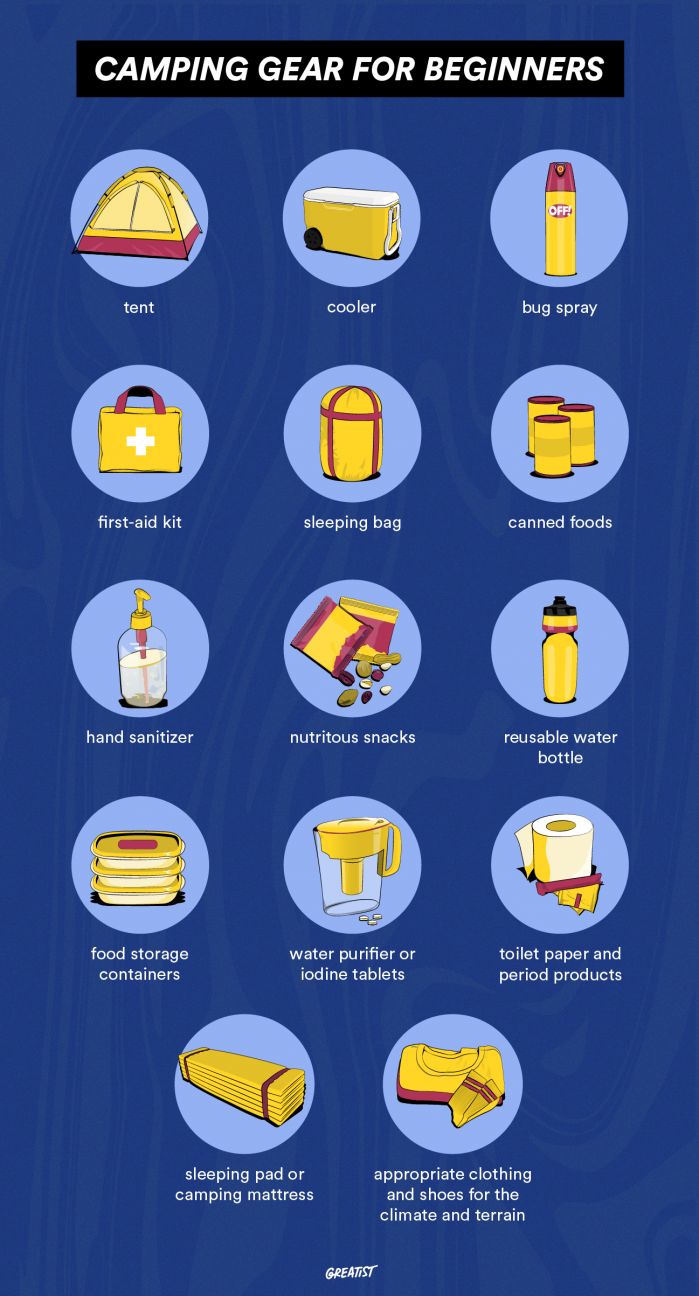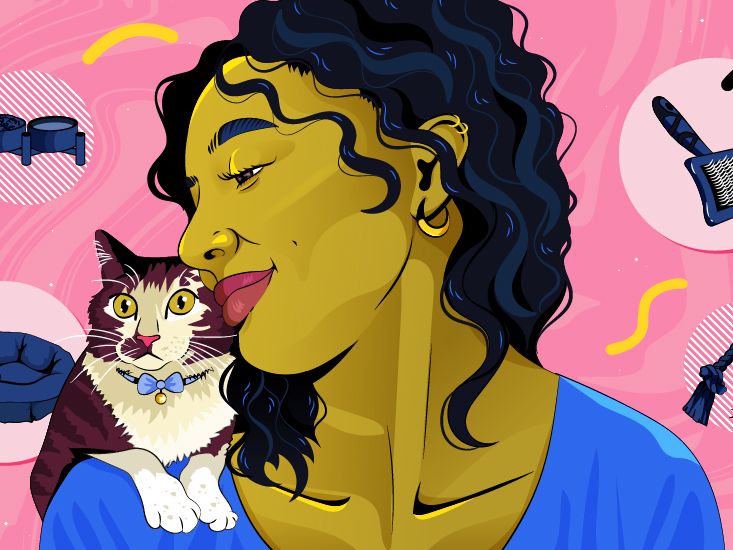We include products we think are useful for our readers. If you buy through links on this page, we may earn a small commission. Here’s our process.
Greatist only shows you brands and products that we stand behind.
Our team thoroughly researches and evaluates the recommendations we make on our site. To establish that the product manufacturers addressed safety and efficacy standards, we:- Evaluate ingredients and composition: Do they have the potential to cause harm?
- Fact-check all health claims: Do they align with the current body of scientific evidence?
- Assess the brand: Does it operate with integrity and adhere to industry best practices?
Car camping can be the best time EVER. Fresh air, good vibes, and limitless s’mores? Sign us up. While it’s less in-tents than backpacking, camping can be intimidating if you’re new to the game. But don’t worry! We have you covered. Here’s what you need to know before you go.
Gear starter kit: The essentials
Here’s what gear you should grab before you head out:
- tent
- cooler
- bug spray
- first aid kit
- sleeping bag
- canned foods
- hand sanitizer
- nutritious snacks
- reusable water bottle
- flashlight or headlamp
- spare batteries sealed in a zipped bag
- food storage containers
- water purifier or iodine tablets
- toilet paper and period products
- sleeping pad or camping mattress
- appropriate clothing and shoes for the climate and terrain
First things first! Here’s a deep dive into camping basics. We talked to Jasper Springfield, founder of Roving Motion, a team of rubber tramp pros who seek to teach folks about life on the road. Springfield has camped throughout the 48 continental states and parts of Canada. So it’s safe to say he knows what’s up.
Trip prep and research
There’s something special about hopping in your car and hitting the open road. But it’s important to have some sort of a game plan, especially if you’re new to camping.
Your safest bet is to research campsites near you. This way you can learn the basics in a familiar environment before pulling the trigger on a cross-country trip.
You should also look into which spots provide fire pits, fire wood, indoor toilets, purified water taps, and overnight tent grounds.
Cost can also be a factor. Some campgrounds require a nightly stay charge. But according to Springfield, there are “tons and tons of federal lands like National Forests and Bureau of Land Management where you can camp for free for up to 14 days usually.”
Keep in mind, these campsites don’t offer a “glamping” experience. You won’t have modern amenities like running water or electricity.
Camping etiquette
Here are some camping tips to keep your experience a 10/10 for you, other campers, and the environment.
Follow the rules. Respect your campsite’s regulations. There should be posted signs that lay down the law. You can also see if there’s a ranger around.
Fire safety. Always follow fire safety protocol as if Smokey the Bear is standing next to you. Never put cigarettes out on the ground. Always snuff out your bonfire. And please, do NOT burn your trash.
BTW, you also have to be aware of the wind.
“At best it will make you burn through your firewood quicker,” Springfield says. “At worst, it can send embers flying away from your campsite, igniting a wildfire.”
Keep it clean. Even though you’re sleeping on dirt, camping involves a lot of cleaning up. Make sure you follow the “Leave No Trace” practice and leave your site as you found it.
Volume control. We all love a sweet “Kumbaya” sesh. But try to keep the excess noise to a minimum and respect your neighbors. Springfield also notes you should be aware of your lighting.
“Being able to see around your campsite it great, but blinding your neighbors isn’t nice,” he says. “Plus, the bright lights will make it hard to see the stars at night.”
Creature concerns. Research local wildlife before you get going. Be particularly careful during bear season and always have a deterrent (aka bear spray) on you just in case. Do not leave food out as this can attract wildlife (in some areas you’ll need to hoist your food up in a tree to keep it away from bears).
Meal planning
You prob won’t find a Trader Joe’s in the middle of the woods. So it’s uber important to plan all of your meals ahead of time.
Here are some tasty options that will keep the whole fam fueled:
- trail mix
- dried fruit
- protein bars
- granola bars
- meat skewers
- foil-wrapped potatoes
- pre-packed sandwiches
- canned soups and meats
- franks and beans (a classic)
Pro tip: “There are plenty of foods that people envision while camping, like trail mix, but nobody gets excited about it once they get to camp,” Springfield says. “So be honest about what you want to eat once you get out there.”
What about water?
A lot of campgrounds have a potable water source. But that’s not always the case. Open water sources can get sketch. They can be contaminated by human or animal waste and contain nasty parasites, according to the Bureau of Land Management (BLM).
“If you find out that there’s no water source in the area, bring the water with you,” Springfield says. “But you should also have an emergency ration of water stashed just in case.”
You should also pack some iodine tablets and water purifiers as a plan B.
Setting up camp
Here’s a step-by-step rundown of setting up your campsite.
1. Select your spot
If possible, pick a flat piece of land. It’s better on your back and will keep your tent more stable. Lots of peeps also prefer to set up in a shady area. Trees can block out the sun and protect you from harsh winds. But you have to be careful.
“Always look up before setting up a tent, especially if you’re under a tree,” Springfield says. “You don’t want to set up under any widow-makers (loose or broken limbs that are dangling in the tree above).”
2. Set up your tent
Tents aren’t just for sleeping. They’re a great place to unpack your other gear and get organized. But! Springfield notes it’s never a good idea to keep food or scented products in your living space.
“It will invite insects and wildlife into your tent,” he says. “Even if it doesn’t attract a bear, rodents are known to chew through tents or packs to get to a food source.”
Instead, he recommends storing food and toiletries in your car when not in use.
3. Food prep
Take a moment to organize your food rations. Double-check that everything that needs to be stored in a cooler is safe and sound.
“If you’re camping and the weather is cool, you can use the ambient air as a fridge or freezer,” Springfield says. “But in the summer, it may not be worth the battle of trying to keep things cool with ice, but that’s a preference for each camper.”
4. Fire pit
Some campsites offer fire pits or grills. But if these aren’t available in your area you can set up a fire pit. Make sure it has a 15-foot radius from trees or brush to reduce the risk of fire.
Reminder: Check with a park ranger or local fire department to make sure this is OK first.
When nature calls: Restroom breaks
Lots of modern campgrounds have a communal bathroom on site. But that won’t be the case if you’re boon-docking or dry camping (aka camping without amenities). Here’s how to take care of business.
Pooping
- Pick a spot at least 200 feet from your camping site.
- Dig a hole 6 inches into the ground.
- Get into a wide-legged squat position.
- Drop your deuce.
- Wipe with all-natural toilet paper (front to back!)
- Bury your poo.
- Use hand sanitizer.
Pro tip: If you go camping on the reg, you may want to purchase a portable toilet.
Peeing (for female bodies)
This is pretty straightforward.
- Find a secluded spot at least 200 feet away from a water source.
- Pull your pants down to mid-thigh level to prevent splashback.
- Get into a squatting position and have at it.
Period
Menstrual cups or period panties might be your best bet when camping. They take up less space in your bag and you don’t have to worry about finding a garbage can. Bonus: They’re eco-friendly!
If you don’t want to ditch the tampons, try to stick to brands that don’t require plastic applicators. When you need to dispose of a used tampon or pad, place them in a tightly sealed bag. Then find an appropriate location (e.g. trash area) to dispose them.
Safety, weather, and wildlife
When it comes to camping, nothing is s’more important than safety. Here’s how to prep for the “what if” situations.
Safety
Know your surroundings. Don’t wander off into isolated or sketchy areas. You may also want to get a hiking GPS if you plan on hitting up some trails.
Swim safety. Even if you were the captain of your high school swim team, you should never swim alone. You also need to wear a life jacket if you plan on kayaking or boating.
Be prepared. Have a well-stocked first aid kit on hand at all times. It doesn’t need to be as hardcore as a disaster go-bag, but it should def have the essentials.
Stay in touch. Satellite messengers are a great tool to keep on hand.
“If you spend time in the wilderness, this can save your life,” Springfield says. “It is worth its weight in gold if you find yourself in need of help.”
Weather
The heat stroke struggle is real fam. Stay extra hydrated on hot or humid days. It’s also a good idea to avoid direct sunlight in the afternoon. As for cold camping, it’s all about insulation. Make sure you layer up!
Wildlife
Squirrels are the CUTEST. But these fluffy critters and their furry friends can carry diseases like rabies and tetanus. That said, do NOT approach any animals. You should also look into what venomous insects or snakes might be chilling in your camping area.
P.S. Check for ticks on the reg.
Now that you know the camping basics, it’s time to go shopping! Here’s your go-to camping gear guide.
Tent essentials
It’s time for TENTx Talks. Here are some tips for the best outdoor sleep experience.
Tent
Keep these things in mind when shopping for a camping tent:
Decide on the size. This really depends on how many people you’re shacking up with. If it’s just you then stick to a small one. But if it’s you and a partner go for the three-person tent. You’ll have more room for activities.
Think about the weather. Four-season tents are super versatile because you can use them year-round. They come with extra flaps for extra protection in the colder months. It also comes with vents for better air flow in the summer season.
“You’ll want to make sure you have a rain fly, a tent, and a tent footprint,” Springfield says.
Ease of use. Some tents can be a pain in A to set up. If you’re just going on a 2-day vacay you don’t want to spend half that time figuring out which pole goes where. You can avoid tent stress by setting it up at home first.
Durability. Most name brand tents are designed for durability. But it’s still a good idea to get a tent that can withstand the elements.
Sleeping bags
Here are some questions to ask yourself when you buy a sleeping bag:
- Is it waterproof?
- What shape is it?
- What is it insulated with?
- How many people does it fit?
- Will I freeze and/or sweat to death?
Camping mattress
A sleeping pad or camping mattress can provide top-notch comfort and support. But most importantly, they offer insulation from the ground. They should be easy to store, fast to inflate, and hella comfortable. Here’s a list of our top picks.
Alternatively, you can get a portable camping hammock.
The fire pit
Fire pits are one of the best parts of the camping experience. Here’s what you need.
Chairs
The ideal camping chair should be comfortable, durable, and easy to carry. They come in lots of different styles like:
- classic camp chair
- low-to-the-ground chair
- rocker
- suspended chair
- scoop chair
- camp stool
- two-legged chair
- three-legged chair
Any of these options can be cozy AF. It’s all about what you like best.
Wood
Some campsites sell firewood. But you might want to bring a couple of fire logs to get the party started.
“If you’re going to collect your own firewood, look for dead standing wood,” Springfield says. “It’s any dead tree or branch that’s not laying on the ground. Wood on the ground is often water logged and rotten.”
PSA: Don’t pull a Paul Bunyan and go to town on trees. Only chop wood if you’re positive it’s allowed in the area. Remember, Smokey the Bear is watching you 🐻.
Fire starting materials
Here’s some stuff you can find in the forest for your fire:
- Tinder. (No, not that Tinder). This includes dry leaves, pine needles, or anything else that’s easily combustible.
- Kindling: This consists of small sticks or twigs that help fire up the flames.
- Firewood. You can stack your wood in a cone, log cabin, or pyramid formation for a longer burn.
And here’s what you should bring with you from home:
- matches
- long-reach lighter
- fire poker (optional)
- a bucket to help you put the fire out
P.S. Some campgrounds don’t allow fires period.
“A quick call to the ranger station, talking with a camp host, or calling local fire departments can get that answer for you about fire bans or restrictions,” Springfield says.
Skewers for roasting foods
You can totes go old school and use a twig to roast your weenies. But you might have a tastier (and less splintery) experience with metal BBQ skewers.
Food and “kitchen”
This is what you need to cook and store your food safely:
Cooler
Coolers have come a long way over the years. Some modern models can keep your food fresh for hours on end.
If outdoor dining is something you enjoy on the reg, you may want to invest in a portable refrigerator. These battery-operated bad boys can keep things cold for days and days. Just keep in mind, they can get super spendy.
Safe packaging
You probably won’t run into the Blair Witch on your next camping adventure. But chances are you’ll encounter some critters. So make sure you store your food in a secured container.
FYI: If you’re in bear country, take advantage of bear safety lockers. If they’re not available you should store your food in bear bags. Hang the bags in a tree 10 to 12 feet off the ground at least 200 feet from your sleep spot.
Cookware
Here are some solid options for cooking in the great outdoors:
- fire pit grill
- coffee press
- metal skewers
- open fire kettle
- cast iron skillet
- metal cooking spoon and spatula (plastic may melt)
As for utensils, cups, and plates, lots of camping enthusiasts prefer stainless steel. They’re super-duper durable and more eco-friendly than paper or plastic.
“When considering cookware, think about weight if you’re going to be hiking with any of it,” Springfield says. “A coffee cup, plate, bowl, fork, knife, and spoon can get you pretty far.”
Grooming
No one needs to look like they’re going to the Met Gala on a camping trip. But it’s still important to bring some basic hygiene and protective products with you.
Bug spray
Pesky pests can put a huge damper on your camping experience. Be sure to stock up on bug spray before you hit the trails. And these days, there are tons of natural products to choose from.
Sunscreen
You should wear sunscreen every day, even if you’re under heavy tree coverage. Stick to SPF 30 or higher and reapply throughout the day.
“Also consider wearing a hat, long sleeves, long pants, and UPF clothing,” Springfield says.
Dry shampoo
You might not get a chance to scrub-a-dub-dub when you’re camping. But a quick hit of dry shampoo can keep your hair feeling fresh.
Toiletries
Lots of peeps like to bring their own toilet paper when they go camping. But(t) if you want to go au naturel and wipe with leaves, more power to you. Just make sure it’s not poison oak 😬. And remember that hand sanitizer.
Camp clothing
You definitely don’t have to dress to impress when you’re in the woods. But it’s super important to pick clothes that can help you thrive in the elements.
Hot weather
Cotton and camping aren’t a great combo. It absorbs more water than other fabrics which can leave you feeling wet and sticky all day long. Instead, wear breathable fabrics like loose linens in the summer and light synthetic blends. You should also avoid dark colors that absorb heat.
Cold weather
Thermals are your friend. Also invest in a top-notch insulated winter coat, gloves, and wool socks. Long underwear, a thick hat, and waterproof boots are also a great idea.






